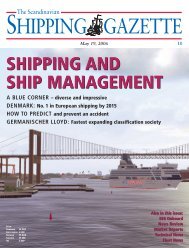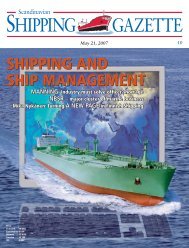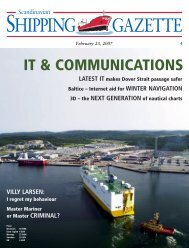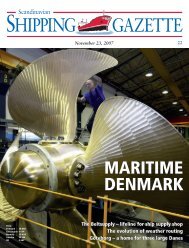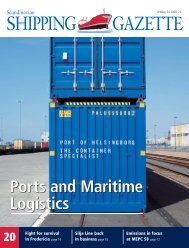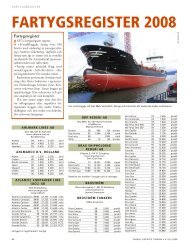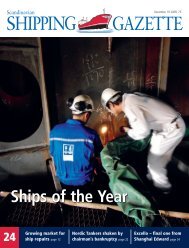SSG No 20 - Shipgaz
SSG No 20 - Shipgaz
SSG No 20 - Shipgaz
You also want an ePaper? Increase the reach of your titles
YUMPU automatically turns print PDFs into web optimized ePapers that Google loves.
Wet – scrapping old aframax tonnage<br />
<strong>No</strong>vember stems saw aframax freight<br />
firm quite a bit into the second half<br />
of October as a temporary shortage of<br />
spot tonnage developed for relatively early<br />
delivery. Good demand forced rates trough<br />
WS 100 to reach WS 1<strong>20</strong> in both the <strong>No</strong>rth<br />
Sea and the Baltic. Even so, freight is lower<br />
than in the second half of September when<br />
it reached this autumn’s peak of WS 150<br />
for the <strong>No</strong>rth Sea and WS 130 for 100,000<br />
tonnes out of Primorsk. Fundamentals have<br />
not changed much in the past month characterised<br />
by both too much tonnage and<br />
too meagre demand. Therefore the aframax<br />
has for all intent and purpose remained in<br />
the doldrums since mid-year, despite the<br />
one peak period. Analysts like to call it<br />
freight volatility.<br />
The one positive aspect of this development<br />
is that owners might send single-skin<br />
vessels to the breakers. Scrap prices ought<br />
to tempting at around USD 500 per lightweight<br />
ton. At least it should be more<br />
tempting than continued trading at dismal<br />
freight levels. In our June report we noted,<br />
When front haul rates for capesize tonnage<br />
move close to USD 230,000 per<br />
day, as it did from Continent to the Far<br />
East towards the middle of October, we<br />
can safely say we have a good dry bulk<br />
market. Mind you, the capesize market<br />
has since consolidated and fallen back a<br />
little. One wonders if a peak was reached<br />
by mid-October and that this is a far as the<br />
market will go. Confidence, for what it is<br />
worth at this stage, remains solid. Another<br />
measure of the confidence in the cape market<br />
was that Chinese charterers paid USD<br />
155,000 per day for a 174,000 tonner for 12<br />
months. Even though the Far Eastern market<br />
remained firm, while the Atlantic fell a<br />
little, the transatlantic round voyage still<br />
stood at USD 177,000 per day.<br />
While the capesize tonnage in the Atlantic<br />
consolidated, the Atlantic panamax continued<br />
ever upwards to new heights. Such is<br />
the market that an increase of USD 4,500<br />
per day to close to USD 85,000 per day on<br />
the transatlantic round voyage made a leading<br />
broker say that the pace of the increase<br />
“aframax freight nearly halved”. Freight has<br />
not really recovered since then. Demand<br />
for suezmax tonnage also picked up during<br />
the period covered, but made little or no<br />
impact on the freight level.<br />
MR (Medium Range) freight for transatlantic<br />
business westbound has firmed lately<br />
in panamax freight had slowed down. The<br />
equivalent Far East round voyage was close<br />
to USD 92,000 per day and as much as<br />
USD 95,000 per day was also paid for an<br />
Australian round voyage.<br />
In the handy/handymax market the rate<br />
from the US Gulf to the Continent, which<br />
MARKET REPORTS<br />
and was just going through WS <strong>20</strong>0 for the<br />
first time since the middle of August. MR<br />
freight has, in fact firmed steadily since the<br />
beginning of October. The last time the rate<br />
went to WS <strong>20</strong>0 it fell back quit sharply to<br />
WS 155 and remained between WS 155<br />
and WS 170 for a good many weeks.<br />
Wet bulk freight development<br />
Worldscale ■ Suezmax <strong>No</strong>rth Sea–TA ■ Aframax NS– UKCont<br />
■ Aframax Primorsk–UKCont ■ Clean MR UKCont–TA ■ Clean Baltic–UKCont<br />
Dry – dry bulk at dizzy heights<br />
400<br />
300<br />
<strong>20</strong>0<br />
100<br />
0<br />
180,000<br />
150,000<br />
1<strong>20</strong>,000<br />
90,000<br />
60,000<br />
30,000<br />
0<br />
Jan ’06<br />
Apr ’06<br />
has been firm for some considerable time,<br />
was coming ever closer to USD 100,000 per<br />
day. Short period fixtures were concluded<br />
at USD 77,000 per day for handymax tonnage,<br />
while the transatlantic round voyage<br />
was closing on USD 72,000 per day.<br />
petter arentz<br />
SCANDINAVIAN SHIPPING GAZETTE • OCTOBER 26, <strong>20</strong>07 83<br />
Jul ’06<br />
Oct ’06<br />
Jan ’07<br />
Apr ’07<br />
Jul ’07<br />
Oct ’07<br />
Source: <strong>SSG</strong>, October 18, <strong>20</strong>07<br />
Dry bulk freight development<br />
Atlantic round voyage,USD/day ■ Capesize ■ Panamax ■ Handymax<br />
Jan ’06<br />
Apr ’06<br />
Jul ’06<br />
Oct ’06<br />
Jan ’07<br />
Apr '07<br />
Jul ’07<br />
Oct ’07<br />
Source: Fearnleys/<strong>SSG</strong>, October 18, <strong>20</strong>07




